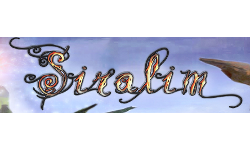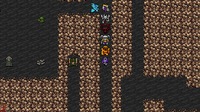|
|

|
PLATFORM
|
PS Vita
|
BATTLE SYSTEM
|

|
INTERACTION
|

|
ORIGINALITY
|

|
STORY
|

|
MUSIC & SOUND
|

|
VISUALS
|

|
CHALLENGE
|
Adjustable
|
COMPLETION TIME
|
More than 80 Hours
|
|
OVERALL

|
+ Building teams is interesting
- Process too time consuming
- Combat is relatively uninteractive...
- ..and doesn't evolve in meaningful ways
|
Click here for scoring definitions
|
|
|
The promise of an endless game is, in theory, compelling. Who wouldn't want to have a game they can play forever? In the most perfunctory way possible, Siralim can claim this as a success. It acts as a perfect mobile game, one that can be picked up and dropped in the blink of an eye, where returning to it is no challenge whatsoever. However, it's also a game that shows that a game supplying "endless" content is a difficult one to pull off.
Siralim is dungeon-crawling RPG where the player collects the souls of defeated monsters to form a party to fight more monsters. The game gets its name from the castle it takes place in, a vast structure solely focused on monster fighting and creation. As the ruler of the castle, the task of keeping the kingdom safe from the monsters that plague its many realms is the main goal. This is the closest thing the game has to a story and from this point on the player is free to play as they see fit. There are a series of quests that direct the player through the different mechanics and concepts that make up the game, but after that the player is left to their own devices.
After creating the ruler — which really comes down to a choice between the Chaos, Death, Life, Nature, and Sorcery schools of magic, which affects the available perks, the starting creature, and gives a small power boost to that class of spells — players take control right away. As the castle has no front doors, the king or queen enters various realms through a Teleportation Shrine. The realms are made up of floors, each one littered with roaming packs of monsters and useful components. On each floor the player is given a duty, usually in the form of a substandard MMO quest that asks for X amount of Y, that gives players a little bit of direction on the floor, but often times this usually involves clearing the floor until the requirements are met. There are different realms to explore based on the five schools of magic in the game, but the only differences between them are the tileset and what random things are found strewn about the place. Initially, only one realm is available while access to the others must be built in the castle's war room.
 The team of monsters follow behind you at all times.
The team of monsters follow behind you at all times.
|
|
The war room serves as a place to upgrade the castle, from adding new rooms to improving existing rooms. Each of these rooms introduce another system, like the blacksmith who can forge new weapons and improve stats on existing ones and the enchanter who can add abilities to equipment. Siralim does provide guidance through the construction of most of these rooms, though those quests seemed to arbitrarily stop after a seemingly random point, giving the impression that the quest progression may be bugged to some extent.
But missing out on the main quests doesn't interrupt the bulk of the game, which is raising and fighting creatures. Players can build up teams of up to six creatures — which humorously follow in single file — as they travel through the realms. Each type of creature has one unique ability and can equip a single item. These abilities start off fairly basic but become more interesting as more creatures are unlocked. While summoning additional creatures to form parties with, pieces begin to fall into place and strategies begin to present themselves based off ability interaction and creature placement, making team-construction the most interesting aspect of the game, especially once Nether Creatues come into play. Nether creatures are more powerful versions of creatures that require a lot of time and effort into creating but come equipped with a second ability and increased stats. Combined with abilities gained from items and some interesting interplay between creatures becomes the main drive of the game.
In theory, these would carry over to make combat more interesting, but that unfortunately is not the case. Combat is horribly slow, incessantly repetitve, and surprisingly lacking interaction. Creatures have the option to attack a target, defend for the turn, or provoke enemy creatures which lowers defense as well. Enemy creatures share the same functions which ensures that ninety percent of all actions in any given combat are just basic attacks, albeit modified by various abilities. Since the party is fully healed after each battle, fights become a DPS race and offensive play is all that matters. A single defensive creature provoking every turn will keep the heavy hitters nice and healthy. The only time this deviates is with spells, which usually eats up the active creature's turn but gives the player some ability to react to combat. However, equipped spells are quite limited in uses and can only be recharged by randomly dropped items, making their use in combat sparing at best.
 Spells are one of the few opporunities to change up combat.
Spells are one of the few opporunities to change up combat.
|
|
These aspects would normally make for dull combat, but other elements that come into play make the game less fun to play than it should be. For example, while enemy monsters can be seen while exploring, the rest only appear once combat has started. Without the ability to use consumable items or change equipment mid-battle, the player cannot adjust strategies to match the new enemies. This makes it impossible to try and prepare for fights ahead of time, forcing a greater reliance on high-damaging creatures. Certain status ailments and abilities can also pop up that seem to serve no purpose in a fight than to drag it out. Every status ailment and its effects get listed for each creature every turn even though the information is clearly displayed on its portrait. The game also slows to a noticeable crawl when those status effects begin to stack, making battles take even longer. The only time combat takes on a different dynamic is in the Arena, a late game wing of the castle where the player fights enemy parties until he or she fails, but with the added change of not healing in between battles.
It's during these prolonged battles that Siralim shows that the majority of its core game is comprised of busywork and nothing happens organically. Numerous upgrades to the castle and to certain items require rituals, which are fulfilled by gaining energy from defeating creatures. There are five different resources in the game that are collected from creatures and from exploring realms. Without investing Royalty Points, skill points earned when the player levels up, these will come slowly and serve to block progress. With a good chunk of invested points these resources become a non-issue, but all that time and effort that could have gone into specializing the player character or the creatures has now been spent making the flow of the game more bearable. New creatures do not become available the further along the player gets in the dungeon; they're an upgrade from the war room. The various realms don't have specific creatures tied to them; creatures just appear at random. Without investing in additional ritual slots, only one ritual can be active at a time. The Arena offers a change of pace, but an invitation is needed to enter. Invitations are gained at random while exploring dungeons or can be bought with rewarded Arena points, but why enforce a limitation at all?
Enjoyment of Siralim seems highly dependent on how much grind and padding one would be able to handle. The presentation is basic, highly unanimated but endearing in a retro sort of way. Music is serviceable but the soundtrack is too slim and repetitive to rise above that. The Vita version of the game also had a tendency to crash every few hours. The game has a save anywhere function, so this wasn't too big of deal, just enough to condition saving frequently.
There is a kernel of a good idea that lies at that heart of Siralim, but it's buried under so many levels of bloat and filler. In the time it takes to get to the interesting bits, it simply becomes not worth the time investment. What could have been an pleasing time-waster ends up ultimately feeling like eighty hours wasted. There are better games to invest this amount of time in, and Siralim isn't worth it.
Review Archives
|









